Diseases and Pests Management
This page is designed to help New England beekeepers identify, understand, and respond to the most common honey bee diseases and pests found in the region. Short, handpicked video links are included with each entry to support visual identification.
This guide is intended to be practical and field-ready, focusing on issues that actually occur in New England especially during spring, summer, and fall. At the end of the page, you'll also find a list of rare diseases that beekeepers in this region should be aware of, even if they are unlikely to encounter them.
Essential Honey Bee Diseases and Pests Every New England Beekeeper Should Know
These are the most common, impactful, and relevant diseases and pests encountered by beekeepers in New England. Understanding these conditions is critical for maintaining healthy colonies, especially through spring buildup, summer flows, and fall preparation for winter.
- American Foulbrood (AFB) (honey improper for human consumption)
- European Foulbrood (EFB) (honey may be improper for human consumption during active infection)
- Sacbrood Virus (SBV)
- Chalkbrood
- Varroa Mites
- Nosema Disease
- Wax Moths (honey may be improper for human consumption due to feces and silk contamination)
- Small Hive Beetle (SHB) (honey improper for human consumption if slimed/fermented by larvae)
- Deformed Wing Virus (DWV)
- Chronic Bee Paralysis Virus (CBPV)
Rare and Uncommon Honey Bee Diseases in New England
The conditions below are rarely seen in New England, but they are still important to be aware of especially if you import bees, raise queens, or manage hives in varied environments. These diseases may also become more relevant in the future due to climate changes or shifting beekeeping practices.
- Black Queen Cell Virus (BQCV)
- Israeli Acute Paralysis Virus (IAPV)
- Kashmir Bee Virus (KBV)
- Acute Bee Paralysis Virus (ABPV)
- Lake Sinai Virus (LSV)
- Tropilaelaps Mites (not present in the U.S., but a known global threat)
- Stonebrood (honey may be improper for human consumption if visibly moldy)
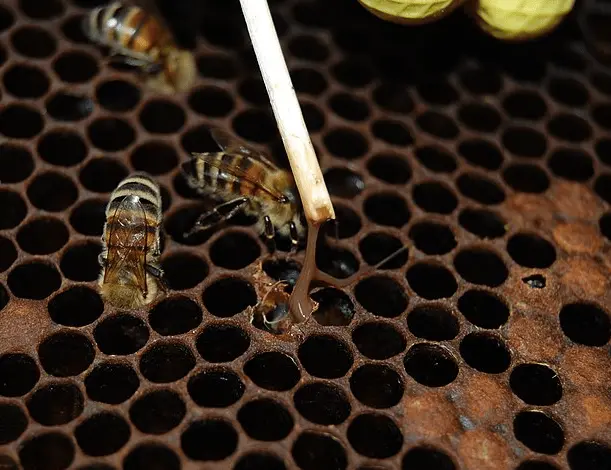
American Foulbrood (AFB)
What is this disease?
American Foulbrood (AFB) is a highly contagious and fatal bacterial disease that affects honey bee larvae. Caused by the spore-forming bacterium Paenibacillus larvae, it leads to the death and decomposition of brood inside the hive.
Scientific Name or Pathogen Type
Paenibacillus larvae — a spore-forming bacterium.
Where it originates
AFB spores are found naturally in the environment but are primarily spread through infected colonies, contaminated equipment, and hive products. Spores can remain viable for over 50 years.
Transmission Method
- Beekeeping equipment and tools shared between colonies
- Robbing and drifting bees that visit infected hives
- Feeding bees contaminated honey or frames
- Reusing old brood comb that contains dormant spores
How frequently this attacks the colony and what season
Though relatively rare in well-managed colonies, outbreaks can occur in spring and summer, when brood rearing is most active. AFB can devastate colonies if not detected and handled promptly.
What colonies are more prone to get it
- Colonies weakened by mites, poor nutrition, or stress
-
Hives started from used or uninspected equipment
What the beekeeper can do to prevent it
- Conduct regular inspections of brood frames
- Avoid sharing tools or equipment between hives without sanitizing
- Rotate out old combs every 3–5 years
- Never feed bees honey or wax from unknown sources
- Use irradiated equipment when reusing materials
- Report infections to local apiary inspectors
How to identify (signs and characteristics for the beekeeper to identify it)
- Capped brood is sunken, greasy, and may have holes
- Dead larvae turn into a brown, sticky mass
- Presence of a foul or sulfur-like odor
- The "roping test": poke a matchstick into the cell; decomposed larvae stretch out like mucous
- Hardened scales stick to the lower cell wall and are hard to remove
Symptoms Timeline
- Infection begins in young larvae (<3 days old)
- Death occurs after the cell is capped
- Signs are usually visible 7–10 days after infection
- The disease spreads gradually but persistently if untreated
Comparison with Similar Conditions
| Disease | Key Difference |
|---|---|
| European Foulbrood (EFB) | Larvae die before capping, usually twisted in cell; no foul odor |
| Chalkbrood | Mummified larvae are white or black and dry, not gooey |
| Sacbrood Virus | Larvae form a sac-like skin, are not ropey or smelly |
How to treat once your colony gets it
- Report to Massachusetts state apiary program. IMPORTANT: AFB is a notifiable disease
- MA inspector will burn infected hives and frames completely if confirmed
- Sterilize all tools using a blowtorch or bleach solution (with caution)
- Do not attempt to manage AFB with antibiotics; this is only allowed by veterinary oversight and only suppresses symptoms
- Quarantine all suspect hives and destroy any showing signs
New England-Specific Notes
- In Massachusetts and other New England states, AFB is a legally reportable disease
- Local inspectors will confirm AFB using field test kits or lab analysis
- Spores can survive cold winters, so even dead-out colonies may still harbor infection
- Beekeepers in New England should use strong overwintered colonies and avoid using old donated equipment from unknown sources
Videos to Help Identify the Disease
- https://www.youtube.com/watch?v=VENKKufzMAE
- https://www.youtube.com/watch?v=caliX8JZJ2s
- https://www.youtube.com/watch?v=MAnFr0htfOk
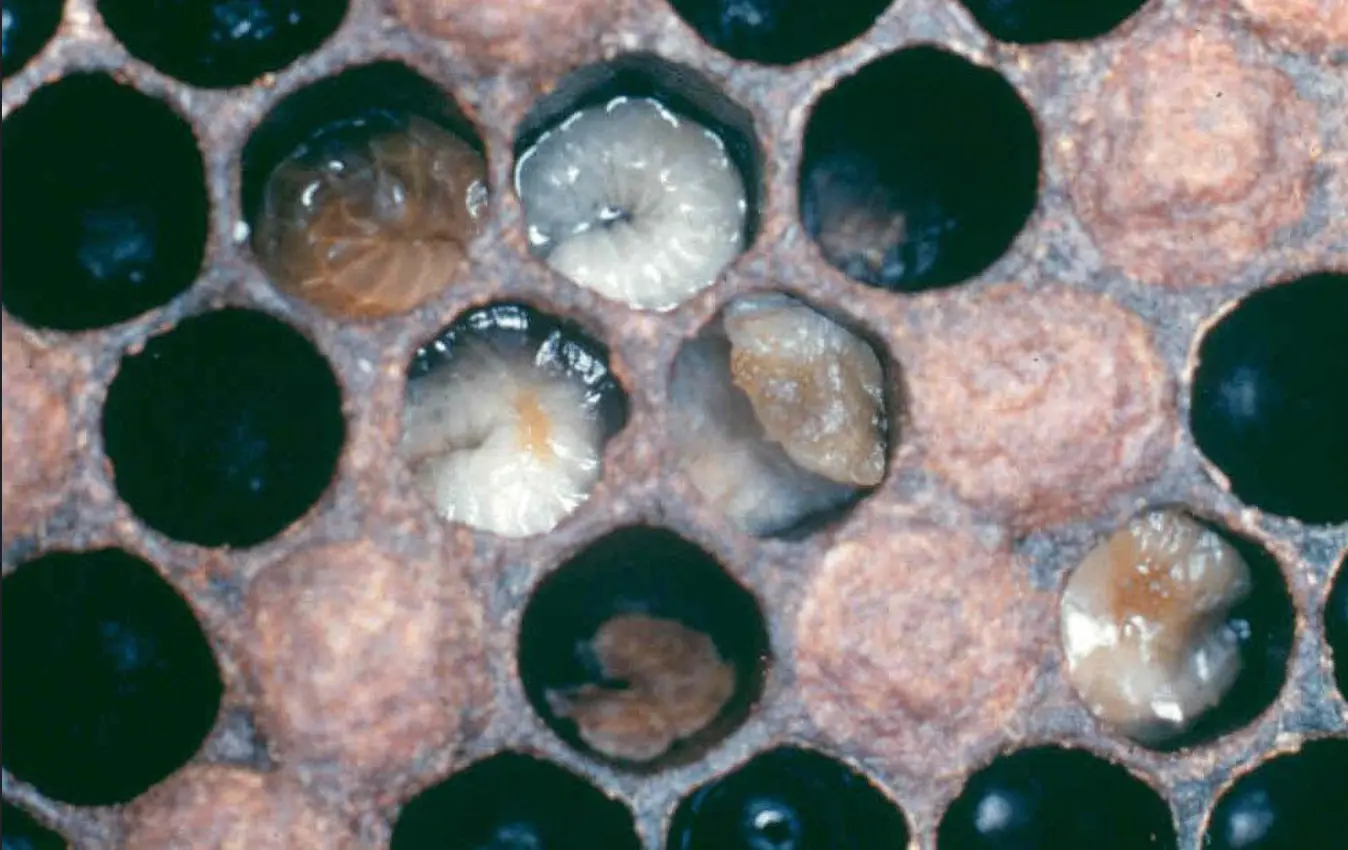
European Foulbrood (EFB)
What is this disease?
European Foulbrood (EFB) is a bacterial brood disease that primarily affects young, uncapped larvae. It is caused by Melissococcus plutonius and results in larvae that die before their cells are capped. Though less destructive than AFB, it can still significantly weaken a colony if left untreated.
Scientific Name or Pathogen Type
Melissococcus plutonius — a non-spore-forming bacterium.
Where it originates
The bacteria are present in the environment and spread easily within and between colonies through nurse bees, contaminated equipment, and robbing behavior.
Transmission Method
- Transmitted by nurse bees when feeding larvae
- Spread by robbing or drifting bees
- Contaminated hive tools, gloves, and equipment
- Reuse of infected brood frames without sterilization
How frequently this attacks the colony and what season
EFB tends to appear in spring and early summer, especially during periods of cool, wet weather or when the colony is under stress. Colonies usually show symptoms sporadically, but multiple-year recurrence is possible if left untreated.
What colonies are more prone to get it
- Colonies with poor nutrition or inadequate pollen
- Overcrowded or stressed hives
- Hives with a young queen and rapid brood expansion
- Colonies exposed to contaminated tools or shared equipment
What the beekeeper can do to prevent it
- Maintain strong, well-fed colonies
- Avoid cross-contamination between hives
- Provide adequate pollen sources or supplements
- Replace old or suspect brood frames regularly
- Monitor brood pattern during spring buildup
How to identify (signs and characteristics for the beekeeper to identify it)
- Affected larvae are twisted in their cells, often yellowish or brown, and die before capping
- Cells may appear sunken or wet, but no foul odor is present
- Larvae may appear melted or deflated
- Scales are not strongly attached and easier to remove than AFB
- Often patchy brood pattern with irregular cell coverage
Symptoms Timeline
- Larvae typically die between 2–4 days old, before cell capping
- Symptoms may fluctuate, clearing up temporarily as colony health improves
- Disease can linger or recur seasonally without comb replacement
Comparison with Similar Conditions
| Disease | Key Difference |
|---|---|
| American Foulbrood (AFB) | Kills larvae after capping; has a foul odor and ropey remains |
| Chalkbrood | Larvae mummify and become chalky and dry |
| Sacbrood Virus | Larvae look like fluid-filled sacs, often with a dark head |
How to treat once your colony gets it
- Requeen the colony
- Boost nutrition with syrup and pollen supplement
- Remove infected frames and replace with clean comb
- Use of oxytetracycline (Terramycin) under veterinary guidance is allowed in some states but often avoided by treatment-free beekeepers
- In mild cases, symptoms may resolve on their own with improved forage and management
New England-Specific Notes
- EFB is common in New England during damp, cool springs
- Some states require reporting of EFB, but it's not always mandatory. IMPORTANT: check your state local apiary program guidelines
- Veterinary Feed Directive (VFD) rules apply if antibiotics are prescribed
- Early intervention and proactive comb rotation are key to preventing long-term issues
Videos to Help Identify the Disease
- https://www.youtube.com/watch?v=LeLNzsAFbJY
- https://www.youtube.com/watch?v=z_2DeJ_-3sg
- https://www.youtube.com/watch?v=_KkyvWeuLBU
- https://www.youtube.com/watch?v=MAnFr0htfOk
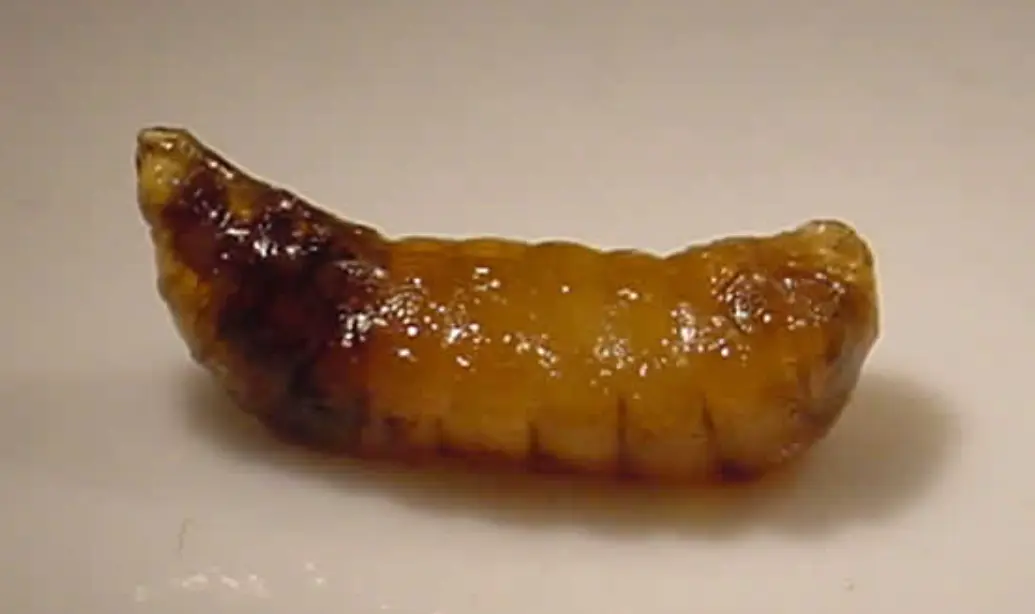
Sacbrood Virus (SBV)
What is this disease?
Sacbrood Virus (SBV) is a viral infection that affects honey bee larvae, preventing them from pupating. Infected larvae die while still stretched out in their cells and develop a distinctive sac-like appearance, making it one of the easier brood diseases to visually identify.
Scientific Name or Pathogen Type
Sacbrood virus — a single-stranded RNA virus in the Iflavirus family.
Where it originates
The virus is present in most bee populations worldwide. It spreads through routine colony activities and can flare up under certain stress conditions.
Transmission Method
- Nurse bees feed infected royal jelly to larvae
- Spread through oral contact and contaminated food
- Can be passed between hives via drifting or robbing bees
- Contaminated tools and beekeeper hands/gloves may also spread the virus
How frequently this attacks the colony and what season
SBV is commonly seen in spring and early summer, especially when colonies experience nutritional stress or high population turnover. Most colonies can tolerate low levels of SBV without major issues.
What colonies are more prone to get it
- Rapidly growing colonies with a high brood-to-nurse bee ratio
- Colonies under nutritional stress or weather-related stress
- Colonies recently recovering from queen replacement or disease
What the beekeeper can do to prevent it
- Ensure adequate pollen and nectar resources during brood buildup
- Rotate old combs and manage congestion
- Reduce bee stress by managing mites, ensuring ventilation, and keeping colonies well-balanced
- Avoid over-inspection during cold or rainy periods (but do not go more than 10 days between inspections)
How to identify (signs and characteristics for the beekeeper to identify it)
- Affected larvae die before pupating, lying stretched out in the cell
- The larvae form a fluid-filled sac. The skin separates from the body
- Head is usually dark and raised
- Dead larvae are not ropey, do not smell foul, and can be easily removed
- Scale left behind is dry and boat-shaped
Symptoms Timeline
- Larvae die at about 4–5 days old, shortly before they would be capped
- Outbreaks may appear suddenly during times of rapid brood rearing
- Symptoms often resolve on their own as colony strength improves
Comparison with Similar Conditions
| Disease | Key Difference |
|---|---|
| American Foulbrood (AFB) | Larvae die after capping, become ropey, foul-smelling |
| European Foulbrood (EFB) | Larvae are twisted, often yellow, and die before capping, but not sac-like |
| Chalkbrood | Larvae become dry, chalky mummies, not fluid-filled sacs |
How to treat once your colony gets it
- No chemical treatment exists. Management is the only approach
- Provide pollen substitutes or protein patties to boost nutrition
- Requeen if the problem persists, as better genetic may help control the virus
- Ensure strong population of nurse bees to care for brood
- Remove combs with heavy signs of infection if necessary
New England-Specific Notes
- SBV is not a reportable disease in Massachusetts or New England states
- Commonly appears in spring, especially after cold spells or nutritional gaps
- SBV often resolves without intervention if colonies are healthy and resources are abundant
- Beekeepers should remain calm and avoid overreacting. Routine management usually works
Videos to Help Identify the Disease
- https://www.youtube.com/watch?v=cmQlDpNOa5A
- https://www.youtube.com/watch?v=z76OA242atY
- https://www.youtube.com/watch?v=MAnFr0htfOk
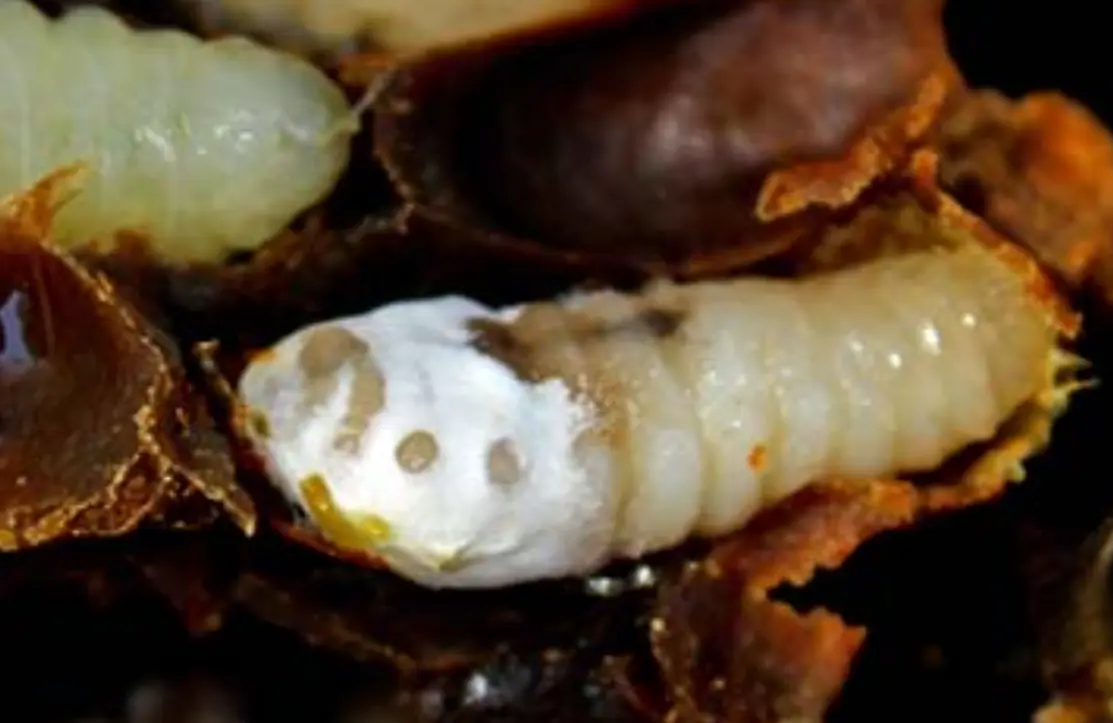
Chalkbrood
What is this disease?
Chalkbrood is a fungal infection that affects honey bee larvae, causing them to die and mummify inside their cells. The dead larvae become chalk-like in appearance, often white or black. Though not usually fatal to the colony, chalkbrood can reduce brood viability and productivity, especially in cool, damp conditions.
Scientific Name or Pathogen Type
Ascosphaera apis — a spore-forming fungus.
Where it originates
The spores of Ascosphaera apis are naturally present in many beehives. They become problematic when conditions favor their growth like typically cold, moist, and poorly ventilated environments.
Transmission Method
- Spread when nurse bees feed larvae contaminated food
- Spores are inhaled or ingested by young larvae
- Can persist in brood combs, hive debris, and tools
- Easily transmitted by beekeeping practices (shared frames, unclean tools)
How frequently this attacks the colony and what season
- Chalkbrood is extremely common in New England and other temperate regions
- Most outbreaks occur in spring or early summer, especially after prolonged cold and wet weather
- Often seen during rapid colony growth or queen replacement
What colonies are more prone to get it
- Weak colonies with low bee-to-brood ratios
- Hives with poor ventilation or excessive moisture
- Colonies in shaded or damp locations
- Stressful conditions such as queen failure or excessive inspections
What the beekeeper can do to prevent it
- Keep hives well-ventilated and elevated off damp ground
- Avoid over-inspecting during cold or wet weather
- Replace old or moldy brood frames regularly
- Requeen with better genetic resistance may help
- Ensure colonies are strong and balanced
How to identify (signs and characteristics for the beekeeper to identify it)
- Larvae die after being capped or just before
- Dead larvae become white, gray, or black mummies
- Mummified larvae are dry, hard, and chalk-like
- Mummies are found scattered in the brood nest or on the bottom board
- No foul odor present
Symptoms Timeline
- Infection occurs when larvae are 3–4 days old
- Visible mummies appear in cells or hive floor in 1–2 weeks
- Symptoms may worsen during cool, wet weather and improve with warmth
Comparison with Similar Conditions
| Disease | Key Difference |
|---|---|
| American Foulbrood (AFB) | Larvae turn into sticky brown goo, foul-smelling |
| European Foulbrood (EFB) | Larvae are twisted, yellowish, die before capping |
| Sacbrood Virus | Larvae appear sac-like and fluid-filled, not dry or chalky |
How to treat once your colony gets it
- Requeen with better genetic if infections persist
- Replace affected brood frames and clean hive bottom boards
- Improve ventilation and reduce humidity
- Move hive to sunnier, drier location if possible
- Boost colony strength with nutritional support
New England-Specific Notes
- Extremely common in New England. Almost all beekeepers encounter it at some point
- Especially prevalent in spring after long, wet winters
- Often resolves naturally as weather warms and colony strengthens
- No need to report. This is not a regulated disease in Massachusetts or nearby states
Videos to Help Identify the Disease
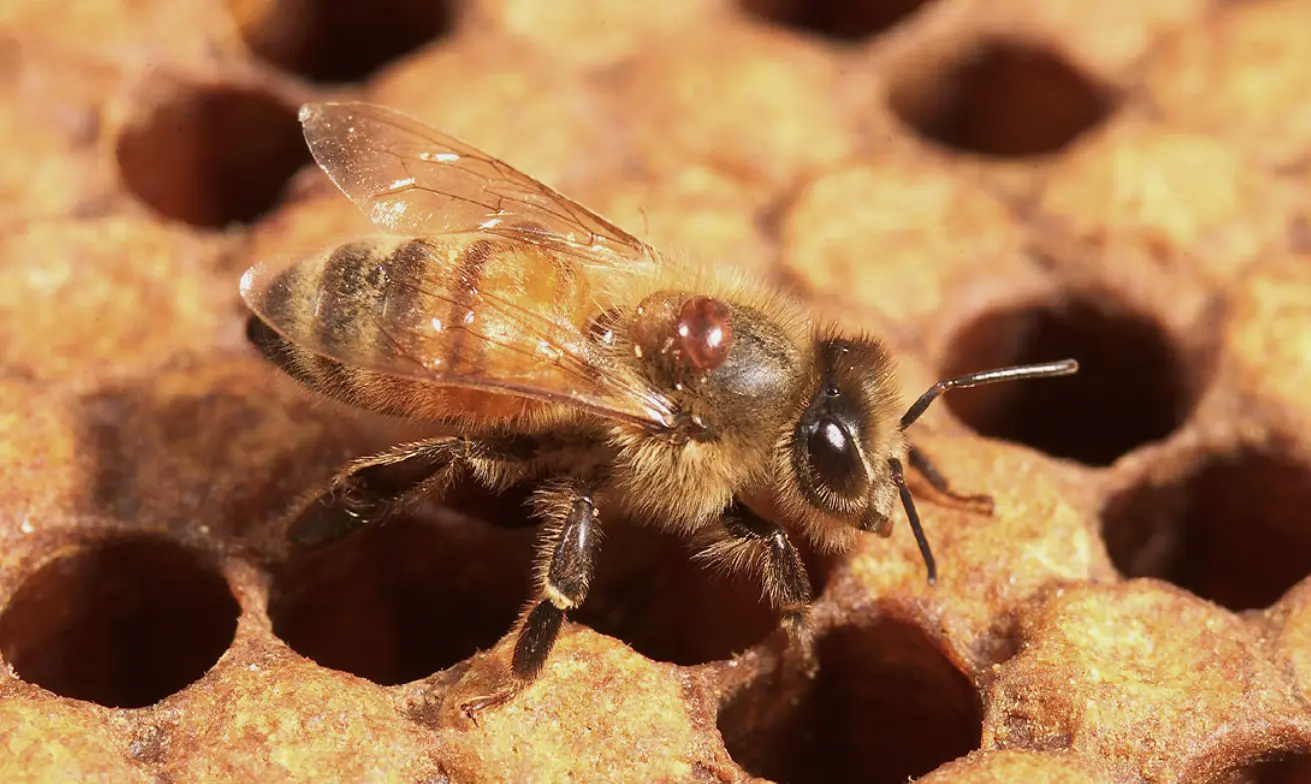
Varroa Mites
What is this disease?
Varroa mites (Varroa destructor) are external parasitic mites that feed on the fat bodies and hemolymph of both adult bees and developing brood. They are considered the most serious threat to honey bee colonies worldwide due to their role in weakening bees and spreading multiple deadly viruses, especially Deformed Wing Virus (DWV).
Scientific Name or Pathogen Type
Varroa destructor — an external parasitic arachnid (mite).
Where it originates
Originally a parasite of the Asian honey bee (Apis cerana), Varroa mites jumped to European honey bees (Apis mellifera) in the 20th century and rapidly spread globally.
Transmission Method
- Spread between colonies by drifting and robbing bees
- Human-mediated through splits, package bees, and nucs
- Mites reproduce inside capped brood cells, particularly drone brood
- Can be transferred via used equipment or frames
How frequently this attacks the colony and what season
- Present in nearly all colonies worldwide
- Reproduce throughout the brood-rearing season
- Populations peak in late summer and early fall, often just before winter preparation
- Unchecked infestations can collapse colonies within months
What colonies are more prone to get it
- Colonies with heavy brood cycles and no mite management
- Hives near untreated or unmanaged colonies ("mite bombs")
- Colonies relying on drone brood production
- Overcrowded apiaries or urban clusters with frequent bee drift
What the beekeeper can do to prevent it
- Perform monthly mite counts using alcohol wash or sugar roll
- Use integrated pest management (IPM): drone brood removal, screened bottom boards, brood breaks
- Treat using legal and approved miticides: formic acid, oxalic acid, etc.
- Avoid bringing in bees from unknown sources without mite evaluation
How to identify (signs and characteristics for the beekeeper to identify it)
- Visible mites: reddish-brown dots on adult bees or pupae
- Deformed Wing Virus (DWV): bees with shriveled wings and shortened abdomens
- Spotty brood patterns and increased drone brood
- Bees crawling at the hive entrance, unable to fly
- High mite counts during alcohol wash or sugar roll tests
Symptoms Timeline
- Mites reproduce in capped brood cells, especially drone cells
- Populations build steadily and peak in late summer
- Virus symptoms lag behind mite levels, often appearing as winter bees are being raised
- Sudden colony collapse often occurs in September–November without warning signs
Comparison with Similar Conditions
| Condition | Key Difference |
|---|---|
| Tracheal mites | Internal mites affecting airways, now rare |
| DWV (alone) | May be present without mites but much less severe |
| Colony Collapse Disorder (CCD) | Sudden loss of bees, not always linked to mites; brood remains intact |
How to treat once your colony gets it
- Confirm infestation with alcohol wash or sugar roll
-
Choose appropriate treatment based on season and colony condition:
- Formic Pro: use in moderate temps, effective on capped brood. Recommended: One treatment anytime from mid-August to mid-September
- Oxalic Acid Vapor: best for broodless periods. Recommended: January, April, June, September(maybe), and October(2 weeks before winterizing)
- Repeat mite monitoring 14 days post-treatment
- Consider splits or brood breaks to reduce mite reproduction
- Maintain treatment rotation to prevent resistance
New England-Specific Notes
- In New England, mite levels often spike after the honey flow, just as colonies are raising winter bees
- Cool, damp falls combined with high mite loads often lead to sudden winter collapse
- Oxalic Acid is legal and commonly used in Massachusetts, including sublimation/vaporization
- Monitoring and treating mites by mid-August is essential for colony survival over winter
Videos to Help Identify the Disease
- https://www.youtube.com/watch?v=69Do8tw_xy0
- https://www.youtube.com/watch?v=D1LzRWG7LdA
- https://www.youtube.com/watch?v=Q3tokmDwQF0
- https://www.youtube.com/watch?v=MAnFr0htfOk
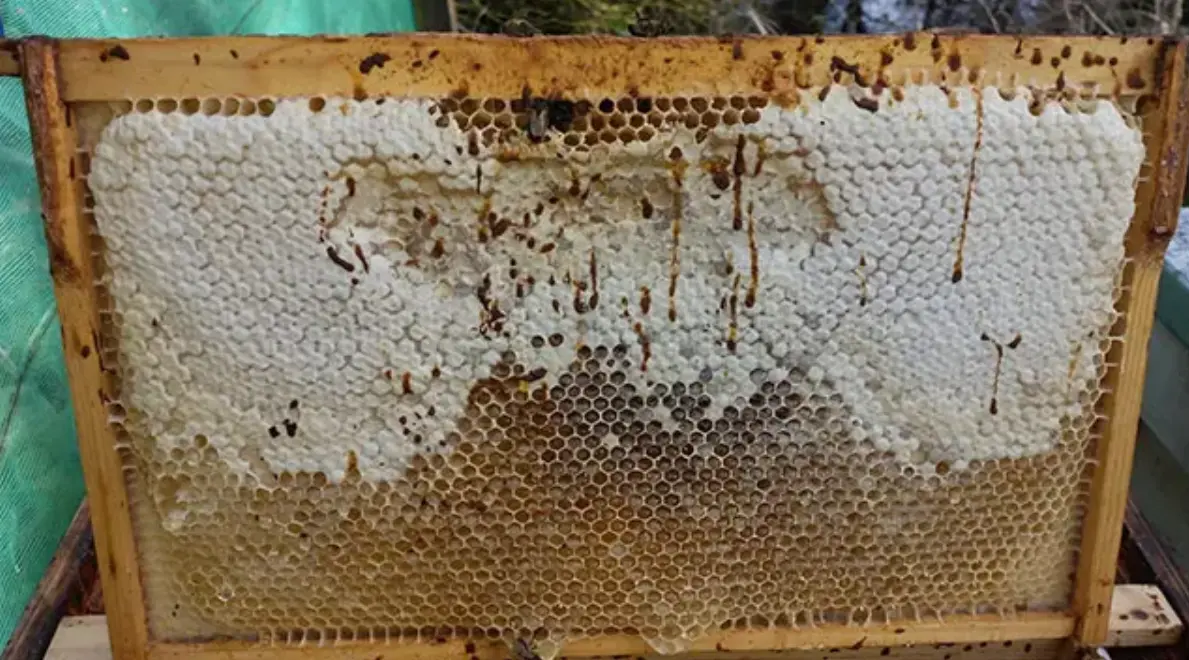
Nosema
What is this disease?
Nosema is a digestive disease of adult honey bees caused by microsporidian parasites. The two main species are Nosema apis and Nosema ceranae. These pathogens infect the midgut lining of adult bees, impairing nutrient absorption and leading to dysentery, reduced lifespan, forager disorientation, and eventually colony decline.
Scientific Name or Pathogen Type
Nosema apis and Nosema ceranae — both are unicellular microsporidian parasites (fungus-like).
Where it originates
- Nosema apis is native to Europe and has long been present in the U.S.
- Nosema ceranae originated in Asian honey bees and has spread globally, now more common than N. apis in North America.
Transmission Method
- Spread through ingestion of contaminated feces or hive materials
- Spores are excreted in bee feces, contaminating hive surfaces, feeders, and comb
- Oral transmission between nurse bees and queen
- Shared hive tools and contaminated water sources also spread spores
How frequently this attacks the colony and what season
- N. apis was more seasonal, typically in early spring
- N. ceranae causes year-round infections, often peaking in late winter and early spring
- Outbreaks worsen under cold, damp, or stressful conditions
What colonies are more prone to get it
- Colonies confined during long winters (no cleansing flights)
- Bees in poorly ventilated or damp hives
- Colonies under nutritional stress, high mite loads, or pesticide exposure
- Hives with old combs with fecal staining
What the beekeeper can do to prevent it
- Ensure bees can make cleansing flights in winter
- Keep hives dry and well-ventilated
- Rotate out old, contaminated combs
- Feed bees high-quality pollen substitute and syrup in late winter
- Keep colonies strong and treated for mites, which suppress immunity
How to identify (signs and characteristics for the beekeeper to identify it)
- Dysentery: yellow-brown streaks at hive entrance or on frames
- Bees appear lethargic, trembling, or unable to fly
- Early queen supersedure or failure
- Foragers may disappear prematurely
- Must use microscopic examination or lab tests to confirm
Symptoms Timeline
- Spores germinate in the bee gut within 4–7 days of ingestion
- Bees may die within 2–3 weeks in severe cases
- Infection typically spreads silently and gradually
- Symptoms worsen under stress, confinement, or poor nutrition
Comparison with Similar Conditions
| Condition | Key Difference |
|---|---|
| Varroa infestation | Mites visible; brood affected; virus symptoms appear |
| Chilled brood | Involves larvae, not adults; caused by cold weather |
| AFB/EFB | Affect brood, not adult bees or gut health |
How to treat once your colony gets it
- No legal medication currently approved in the U.S. (Fumagilin-B formerly used but now banned)
- Improve colony strength: nutrition, ventilation, and brood break
- Requeen if persistent infections occur
- Send samples to lab (e.g., UMass Bee Lab) for spore counts (if you are not sure)
- Replace heavily stained frames and sterilize equipment
- Supportive care is key; the colony often recovers if stress is reduced
New England-Specific Notes
- In New England, long winters and confinement make Nosema a common spring issue
- N. ceranae is now far more common than N. apis in the region
- Beekeepers should inspect hives in late winter/early spring for signs of dysentery
- Regular comb rotation and winter preparation are essential preventive steps
- Sample testing can be done through UMass Extension or local bee labs
Videos to Help Identify the Disease
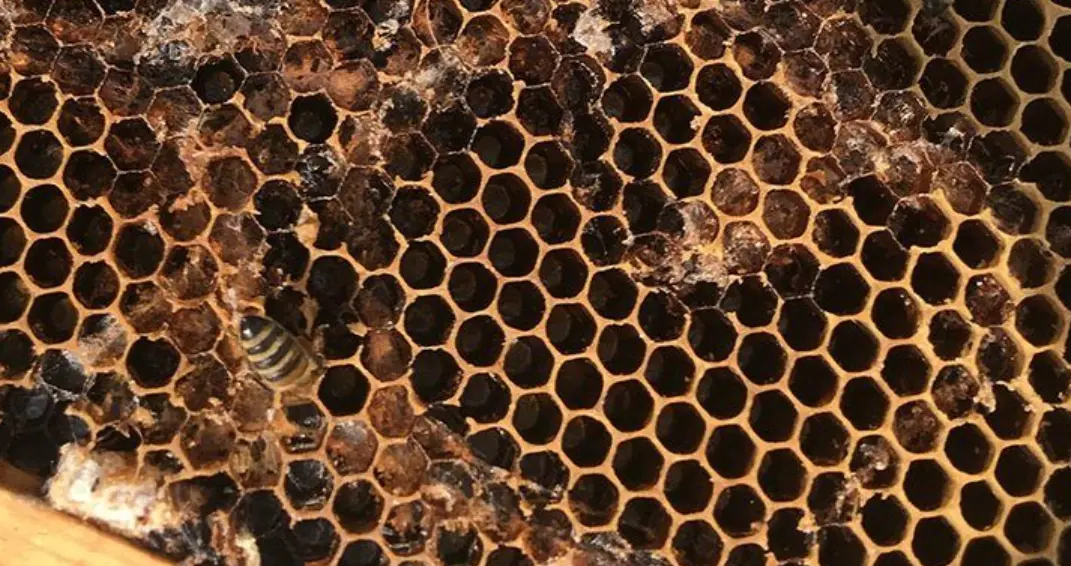
Wax Moths
What is this pest?
Wax moths are destructive pests that invade beehives, particularly weak colonies or stored combs, and destroy wax structures, brood comb, and hive materials. They are not a disease but can cause significant structural damage, contaminate equipment, and disrupt colony function if left unmanaged. There are two types:
- Greater wax moth (Galleria mellonella) — larger, more destructive
- Lesser wax moth (Achroia grisella) — smaller, usually secondary invader
Scientific Name or Pathogen Type
- Galleria mellonella (Greater Wax Moth)
-
Achroia grisella (Lesser Wax Moth)
Both are moth pests (Lepidoptera)
Where it originates
Wax moths are naturally present in most environments where bees are kept. They typically target unused, unguarded, or weak hives, laying eggs in crevices of frames and hive bodies. The larvae then tunnel through wax, feeding on brood comb, pollen, and hive debris.
Transmission Method
- Adult moths enter hives at night to lay eggs in unprotected areas
- Infestation occurs when larvae hatch and burrow through wax comb
- Moths often invade stored equipment, dead-outs, or weak colonies unable to defend themselves
- Spread by neglected supers, frames, or beeyard debris
How frequently this attacks the colony and what season
- Most common in late summer through fall, especially when colonies are weakened
- Frequently seen in stored equipment during the off-season
- May also appear in nucs, splits, or queen-rearing setups if not protected
What colonies are more prone to get it
- Weak or queenless hives with reduced guard bees
- Colonies with high mite loads or disease
- Dead-outs or hives with leftover comb
- Stored frames or boxes without proper protection
What the beekeeper can do to prevent it
- Maintain strong colonies with adequate population
- Freeze or treat stored frames to kill eggs and larvae
- Air-tight storage or light-exposed, well-ventilated areas discourage moths
- Clean and rotate old dark brood combs
- Use moth traps or monitoring tools in storage areas
How to identify (signs and characteristics for the beekeeper to identify it)
- Webbing or silk tunnels throughout the comb
- Comb appears chewed, collapsed, or shredded
- Larvae: white worms with brown heads
- Pupae found in cocoons in crevices of boxes and frames
- Dark fecal pellets and a mothball-like odor in severe infestations
Symptoms Timeline
- Eggs hatch in 3–5 days, larvae grow for 4–6 weeks, depending on temperature
- In ideal warm conditions, a full life cycle completes in 6–8 weeks
- Damage can occur very quickly, especially in unprotected stored combs
Comparison with Similar Conditions
| Issue | Key Difference |
|---|---|
| Mice in hive | Chewed wax and feces, but also wood damage and odor |
| Small hive beetles | Larvae slime comb, but usually require weak colonies |
| Moldy combs | Appear white or fuzzy but lack webbing or larvae |
How to treat once your colony gets it
-
For active colonies:
- Strengthen population or combine with stronger colony
- Remove and freeze infested frames
-
For stored combs:
- Freeze at 0°F (-18°C) for 24–48 hours to kill all stages
- Use paramoth (paradichlorobenzene) ONLY in storage (never near bees)
- Rotate old combs out of use
- Clean and scrape infested boxes, and use light/air exposure in storage
New England-Specific Notes
- In New England, wax moth pressure is lower due to colder winters, but infestations still occur in late summer or poorly stored equipment
- Freezing is highly effective which is an easy option in cold climates
- Stored combs left in barns, garages, or dead-out hives are most vulnerable
- In queen-rearing or NUC operations, wax moths can destroy comb in just a few days if populations are low
Videos to Help Identify the Pest
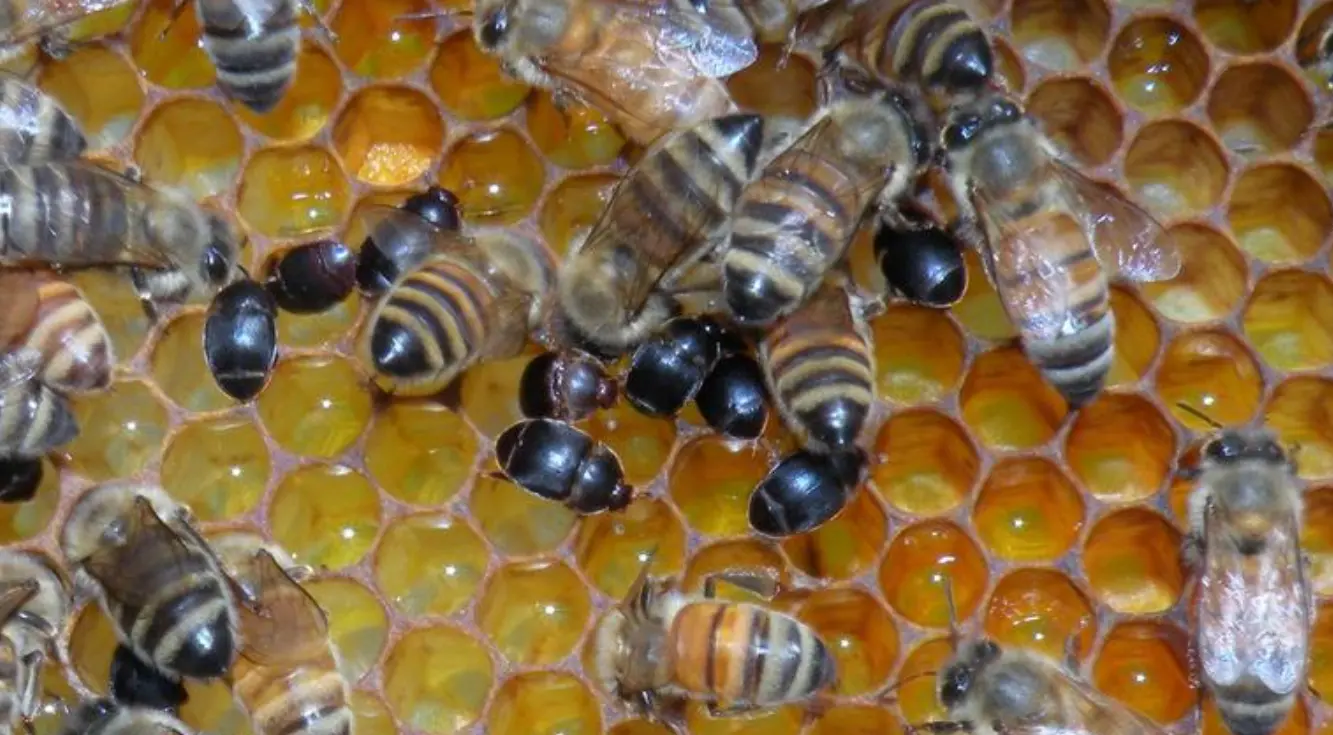
Small Hive Beetle (SHB)
What is this pest?
Small Hive Beetle (SHB) is an invasive beetle pest that lays eggs inside honey bee colonies. The larvae tunnel through combs, feed on pollen and honey, and cause fermentation and slime, which leads to bees abandoning the hive (absconding). While strong colonies can often defend against small infestations, unchecked SHB populations can cause total colony collapse.
Scientific Name or Pathogen Type
Aethina tumida — a coleopteran beetle, native to sub-Saharan Africa.
Where it originates
SHB is native to Africa and was first detected in the United States in 1998. It has since spread throughout most of the U.S., including parts of New England, though it remains less severe in colder climates.
Transmission Method
- Adult beetles fly into hives, attracted by hive odors
- Lay eggs in cracks and crevices inside the hive
- Larvae hatch and burrow through combs, defecating in honey
- Honey ferments and foams, rendering it unusable
- Spread through movement of contaminated equipment or bees
How frequently this attacks the colony and what season
- More common in late summer and early fall
- Populations build up in warm, humid weather
- Less frequent in New England than in southern U.S., but can appear during warm spells
What colonies are more prone to get it
- Weak or queenless hives with low bee numbers
- Hives with excess space (e.g., multiple empty boxes)
- Stored or unattended nucs and mating hives
- Colonies in warm, humid environments or shady locations
What the beekeeper can do to prevent it
- Maintain strong, crowded colonies
- Minimize excess space in hives
- Use SHB traps or oil trays during the active season
- Avoid placing hives in dense shade or overly damp areas
- Freeze or sanitize any suspect equipment or comb before reuse
How to identify (signs and characteristics for the beekeeper to identify it)
- Adult beetles: small (5–7 mm), black, fast-moving on combs or inner covers
- Larvae: resemble wax moth larvae but have distinctive spines and legs
- Fermented, slimy honey and rotting smell in the hive
- Bees may begin to abandon the hive if infestation becomes severe
- Larvae may be seen crawling out of hive to pupate in soil
Symptoms Timeline
- Eggs hatch in 1–3 days, larvae feed for about 7–10 days
- After leaving the hive, larvae pupate in the soil for ~3 weeks
- Entire life cycle can be completed in 3–6 weeks, faster in warm climates
- Colonies can collapse rapidly once slime begins
Comparison with Similar Conditions
| Condition | Key Difference |
|---|---|
| Wax moths | Webbing and cocoons, not slime or fermented honey |
| Nosema or dysentery | Affects adults and gut health, not comb or honey |
| Robbing or fermenting honey | Can occur with heat/humidity, but no beetles present |
How to treat once your colony gets it
- Reduce hive space if colony is too small
- Install beetle traps (oil traps, beetle blasters, etc.)
- Remove heavily infested frames or slime-out combs
- In severe cases, relocate hive to drier, sunnier spot
- Use soil treatments (like diatomaceous earth) around hive stands to kill pupating larvae
- Clean all dead-outs immediately to prevent SHB breeding
- Requeen with better genetics
New England-Specific Notes
- SHB is less prevalent in New England due to colder winters, but is increasingly detected during warm summers
- Nucs and mating hives are particularly vulnerable
- Beekeepers should monitor for SHB during late summer, especially in humid years
- Early action is essential. Larvae slime-out can happen in days
- Stored equipment should be frozen or sealed to avoid infestation
Videos to Help Identify the Pest
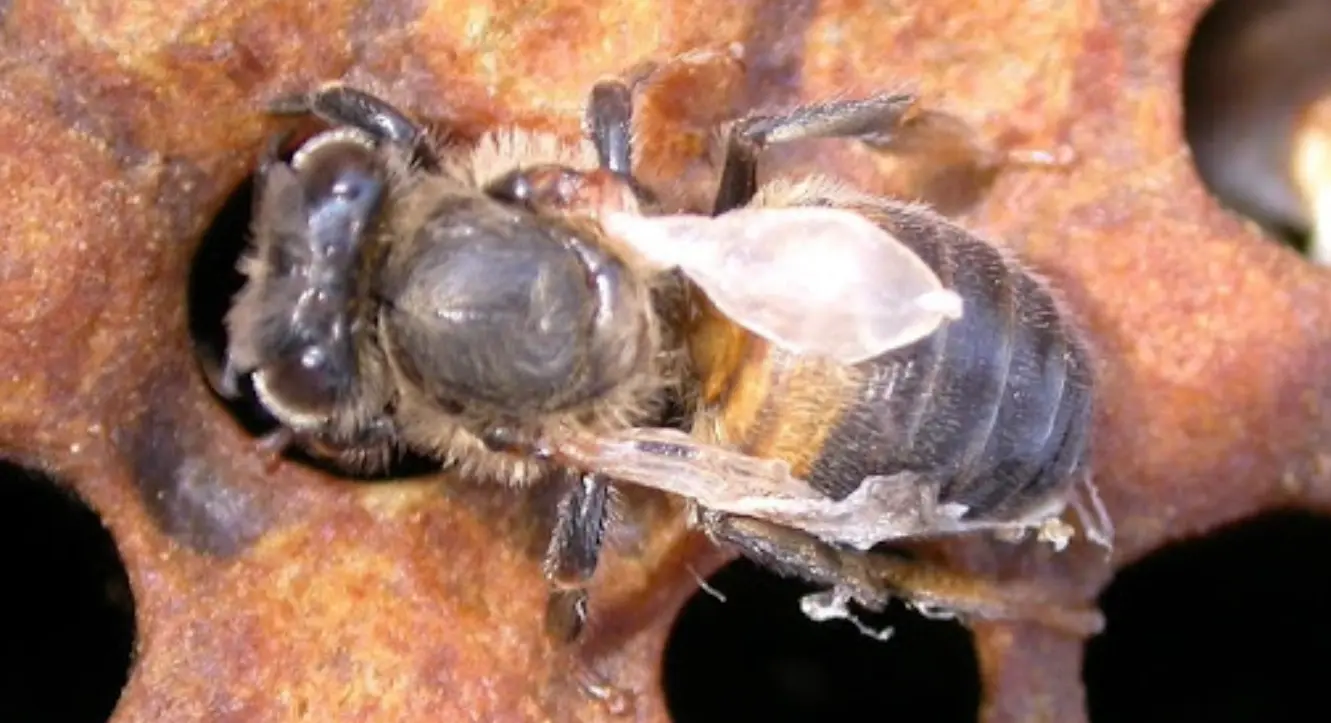
Deformed Wing Virus (DWV)
What is this disease?
Deformed Wing Virus (DWV) is a highly prevalent and damaging virus in honey bee colonies. It causes bees, especially those emerging from infected brood, to develop crippled or misshapen wings, shortened abdomens, and impaired motor function. DWV is primarily transmitted by Varroa mites, and its presence is strongly correlated with colony collapse, especially in fall and winter.
Scientific Name or Pathogen Type
Deformed Wing Virus — a positive-sense single-stranded RNA virus, genus Iflavirus.
Where it originates
DWV is found in low levels in most bee populations, but becomes dangerous when amplified by Varroa mites, which inject the virus directly into developing bees’ bodies during feeding.
Transmission Method
- Varroa mites are the main vector, spreading the virus to pupae during feeding
- Also spread through trophallaxis (mouth-to-mouth feeding) between adult bees
- Can pass from queen to eggs (vertical transmission)
- Contaminated tools, gloves, or feeding equipment may play a minor role
How frequently this attacks the colony and what season
- Present in nearly all colonies, but most harmful when mite levels are high
- Symptoms commonly emerge in late summer and fall, when winter bees are being raised
- Without mite control, DWV levels can spike, leading to winter colony loss
What colonies are more prone to get it
- Colonies with poor or no Varroa control
- Colonies with high drone brood production, which attracts mites
- Hives with late-summer mite spikes, especially after nearby colonies collapse
- Stressed or nutritionally deficient colonies, which may be less able to fight infection
What the beekeeper can do to prevent it
- Maintain strict mite monitoring and treatment schedule
- Use brood breaks, drone comb removal, and other Integrated Pest Management (IPM) practices
- Avoid allowing colonies to drift or rob mite-infested hives
- Requeen with better genetic resistance may help
- Support colonies with adequate nutrition, especially in late summer
How to identify (signs and characteristics for the beekeeper to identify it)
- Bees with crumpled, deformed, or missing wings
- Shortened abdomens, shrunken thorax, or trembling behavior
- Bees unable to fly, often crawling at the hive entrance
- Patchy brood pattern, sometimes mistaken for other diseases
- Sudden fall collapse after a healthy-looking summer
Symptoms Timeline
- Bees infected during development emerge visibly deformed
- Adults infected later may show no visible signs, but die early
- Colonies may seem strong midsummer, then crash within weeks
- DWV becomes critical when winter bees are infected, as these bees must live 4–6 months
Comparison with Similar Conditions
| Condition | Key Difference |
|---|---|
| Varroa infestation | Often present alongside DWV but does not directly deform wings |
| Chronic Bee Paralysis Virus (CBPV) | Affects adult bees with trembling and hairless abdomens |
| K-Wing virus or paralysis | Wings splayed but not crumpled; bees can still fly initially |
How to treat once your colony gets it
- There is no direct antiviral treatment for DWV
- Control Varroa mites immediately: use oxalic acid, formic acid, or other legal miticides
- Consider requeening to improve genetic resistance
- Reduce stress: provide protein supplements, reduce overcrowding, improve ventilation
- Monitor for reinfestation and repeat mite treatment if needed
New England-Specific Notes
- In New England, DWV-related losses peak in late fall and early winter
- Colonies may look fine until after the honey flow, then collapse quickly
- Strong mite control by mid-August is critical to protect winter bees
- DWV is often the final stage in a chain reaction caused by poor mite management
Videos to Help Identify the Disease
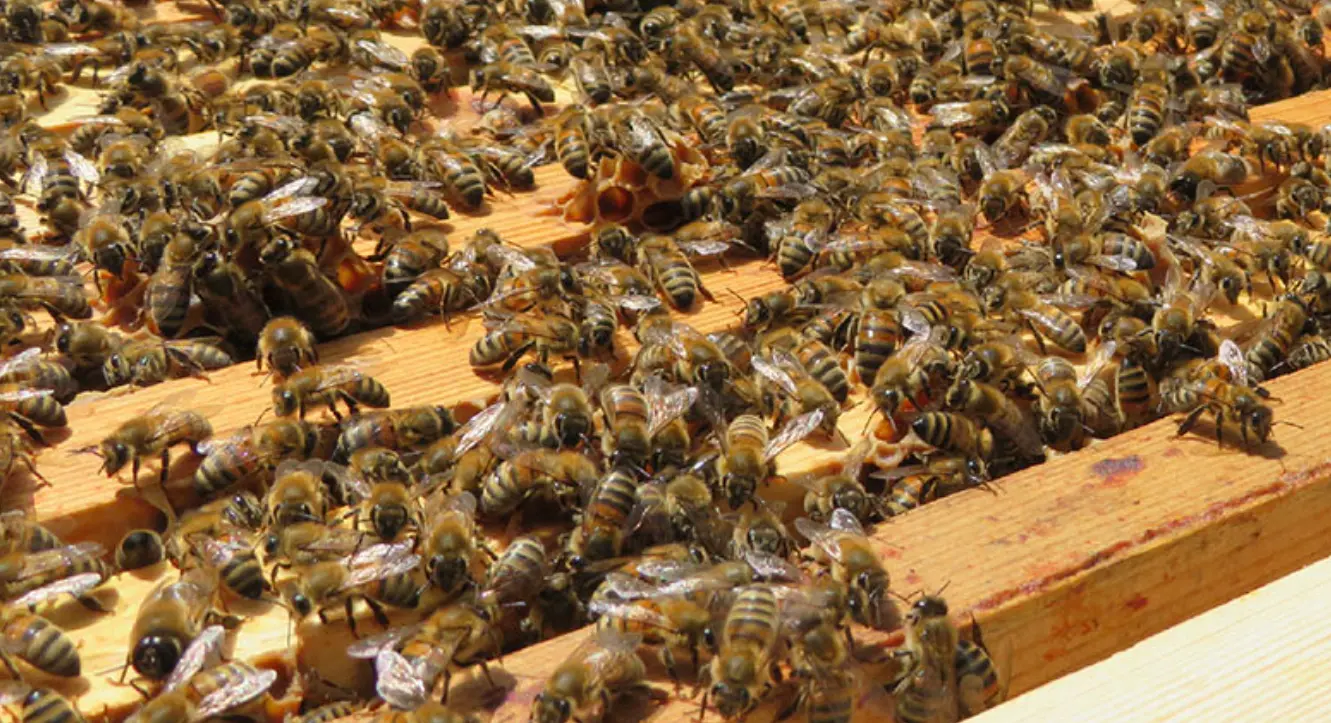
Chronic Bee Paralysis Virus (CBPV)
What is this disease?
Chronic Bee Paralysis Virus (CBPV) is a viral disease that affects adult honey bees, leading to trembling, hair loss, and eventual paralysis and death. Infected bees often appear black and shiny, are unable to fly, and accumulate at the hive entrance. Though not as widespread as DWV, outbreaks can be devastating and rapid.
Scientific Name or Pathogen Type
Chronic Bee Paralysis Virus — a positive-sense single-stranded RNA virus, unclassified but often grouped with iflaviruses.
Where it originates
CBPV is found worldwide but appears in sporadic outbreaks, often linked to high colony stress, poor weather, or mite infestations. It exists at low levels in many colonies but can flare under certain conditions.
Transmission Method
- Spread by contact between bees, especially in crowded colonies
- May be passed through trophallaxis (food exchange)
- Contaminated hive parts or tools may also aid transmission
- Associated with high mite loads, but not exclusively vectored by Varroa
- Can spread via drifting and robbing bees
How frequently this attacks the colony and what season
- CBPV outbreaks can occur at any time, but are most common in spring and early summer, especially in overcrowded colonies
- Not seen in every apiary, but can reoccur seasonally in susceptible operations
- Often underdiagnosed, as symptoms mimic other issues
What colonies are more prone to get it
- Colonies under high population pressure or confinement
- Hives with poor ventilation or excessive moisture
- Colonies recovering from queen loss, mite infestation, or starvation
- Crowded colonies during nectar dearth or poor forage conditions
What the beekeeper can do to prevent it
- Avoid overcrowding colonies, especially in early spring
- Ensure good ventilation and dry conditions
- Control Varroa mites and other stressors
- Requeen with better genetic resistance may help
- Regularly rotate or remove old comb and keep hives clean
How to identify (signs and characteristics for the beekeeper to identify it)
- Bees show trembling, loss of coordination, and inability to fly
- Many bees have shiny black abdomens due to hair loss
- Affected bees often crawl at the hive entrance or on the ground
- Bees may die in piles near the hive
- Queen may appear fine, and brood pattern may be normal or only slightly reduced
Symptoms Timeline
- Symptoms appear within days of infection
- Bees die shortly after symptoms begin
- Outbreaks may persist for several weeks or disappear on their own
- Some colonies may survive and recover, while others collapse quickly
Comparison with Similar Conditions
| Condition | Key Difference |
|---|---|
| Deformed Wing Virus | Affects pupae and adults; wings are visibly deformed |
| Nosema | Causes dysentery and gut problems, not trembling |
| Pesticide poisoning | Can also cause trembling, but often sudden mass death |
How to treat once your colony gets it
- No direct treatment exists. Must focus on colony support
- Requeen with resistant stock
- Reduce stressors: provide nutrition, space, and proper ventilation
- Separate symptomatic bees (e.g., divide or cage queens)
- Some beekeepers report success by shaking bees into clean equipment and requeening
New England-Specific Notes
- CBPV is less common than DWV or Nosema in New England but still appears sporadically, especially in spring
- Cool, damp springs and overwintered colonies bursting with bees can increase risk
- Outbreaks often resolve as conditions improve, but weak colonies may collapse
- Best prevention is early intervention and strong spring management
Videos to Help Identify the Disease
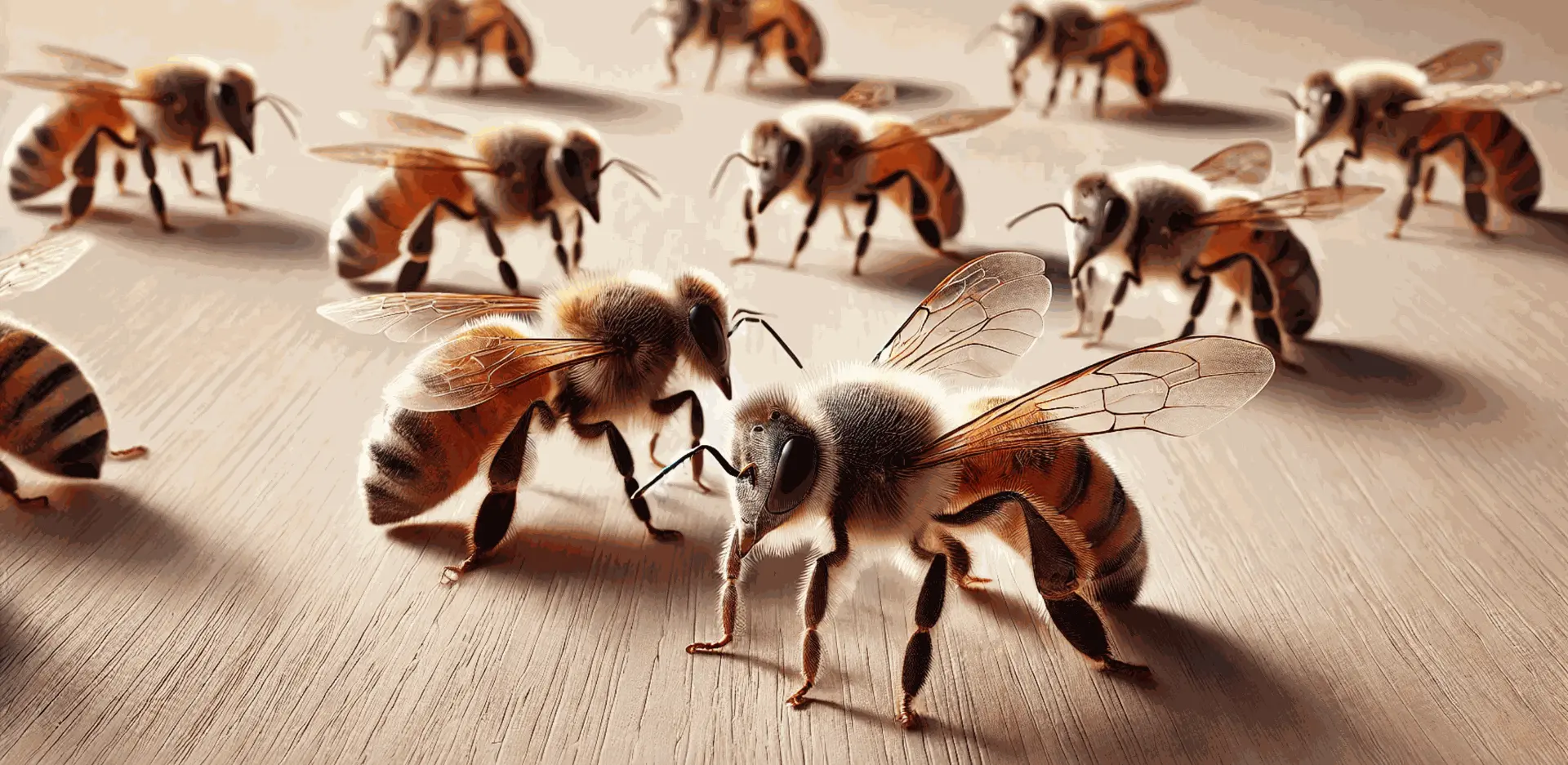
Rare and Uncommon Honey Bee Diseases in New England
While the diseases and pests listed above are the most relevant and widespread in New England, there are other conditions that exist but are rarely seen by beekeepers in this region. Many of them are more common in other parts of the U.S. or under specific environmental or management conditions. Still, it's helpful for beekeepers to be aware of these lesser-known threats in case they arise especially as climate, migratory beekeeping, and bee imports shift over time. Below is a list of uncommon but important honey bee health issues to keep in mind.
Black Queen Cell Virus (BQCV)
What is this disease?
BQCV is a viral disease that targets queen larvae and pupae, turning their developing queen cells brown or black. It is often linked to Nosema infections in adult bees and tends to affect colonies under nutritional or environmental stress.
What colonies are more prone to get it
- Colonies with active Nosema ceranae infections
- Hives raising new queens or with queen supersedure in progress
- Colonies under stress from pollen shortages or overcrowding
What the beekeeper can do to prevent it
- Maintain strong colonies with good nutrition
- Manage and prevent Nosema
- Ensure colonies have enough nurse bees and pollen during queen rearing
How to identify (signs and characteristics for the beekeeper to identify it)
- Queen cells turn dark brown or black before emergence
- Cells may collapse or fail to hatch
- Queen rearing is erratic or unsuccessful
Symptoms Timeline
- Infection occurs in developing queen larvae
- Queen cells darken and fail to emerge over several days
New England-Specific Notes
- Rare in the region, but may appear in spring during artificial queen rearing or heavy Nosema pressure.
Israeli Acute Paralysis Virus (IAPV)
What is this disease?
IAPV is a highly virulent virus linked with sudden bee paralysis and death, often associated with Varroa mite infestations. It is one of the viruses implicated in Colony Collapse Disorder (CCD).
What colonies are more prone to get it
- Colonies with high Varroa loads
- Migratory colonies exposed to multiple stressors
- Bees with poor nutrition or pesticide exposure
What the beekeeper can do to prevent it
- Control Varroa mites aggressively
- Avoid overcrowding and ensure consistent forage availability
- Prevent robbing and drifting between hives
How to identify (signs and characteristics for the beekeeper to identify it)
- Sudden appearance of trembling, disoriented bees
- Massive adult bee death within a short time
- Brood may appear normal, making it hard to diagnose
Symptoms Timeline
- Onset can be very rapid, leading to death within days
- Outbreaks may resolve or result in colony collapse
New England-Specific Notes
- Not commonly confirmed in New England, but can occur with severe Varroa infections.
Kashmir Bee Virus (KBV)
What is this disease?
KBV is a lethal virus affecting adult bees. It leads to sudden adult bee death, often with no visible symptoms. Like IAPV, it is spread by Varroa mites and associated with immune suppression.
What colonies are more prone to get it
- Colonies with Varroa infestation
- Hives exposed to multiple viruses or poor nutrition
What the beekeeper can do to prevent it
- Keep mite levels low
- Maintain good nutrition and hive ventilation
- Prevent robbing from collapsing colonies
How to identify (signs and characteristics for the beekeeper to identify it)
- Sudden drop in adult bee population
- Few or no bees found in front of the hive
- Brood and queen may appear healthy
Symptoms Timeline
- Rapid onset, leading to major losses within days
New England-Specific Notes
- Rare and difficult to confirm without lab testing, but possible under high stress or mite pressure.
Acute Bee Paralysis Virus (ABPV)
What is this disease?
ABPV causes paralysis, trembling, and fast mortality in adult bees. It spreads easily in colonies with high Varroa mite infestation and can lead to sudden hive death.
What colonies are more prone to get it
- Colonies with uncontrolled mite loads
- Hives under thermal or pesticide stress
What the beekeeper can do to prevent it
- Monitor and treat Varroa consistently
- Reduce colony stress through shade, food, and airflow
How to identify (signs and characteristics for the beekeeper to identify it)
- Bees tremble, can’t fly, and die quickly
- Dead bees may accumulate inside or near the hive
- Brood may appear unaffected
Symptoms Timeline
- Symptoms appear in 2–4 days, colony collapse possible within a week
New England-Specific Notes
- Not commonly diagnosed, but may be underreported as DWV or pesticide poisoning.
Lake Sinai Virus (LSV)
What is this disease?
LSV is a relatively newly discovered virus found in many honey bee colonies, often without symptoms. It is believed to affect immune function and longevity in stressed colonies.
What colonies are more prone to get it
- Colonies under nutritional or migratory stress
- Bees with multiple viral or mite-related infections
What the beekeeper can do to prevent it
- Keep bees well-fed with pollen and nectar
- Maintain low mite levels
- Avoid stressful practices like over-inspection or unnecessary manipulation
How to identify (signs and characteristics for the beekeeper to identify it)
- Currently no visible symptoms known
- Confirmed only through lab testing or surveys
Symptoms Timeline
- Likely chronic and long-term in nature
New England-Specific Notes
- No known clinical cases in the region; found only through research-level testing
Tropilaelaps Mites
What is this pest?
A dangerous external mite parasite similar to Varroa, currently not found in the U.S. but a major threat in Asia. It reproduces faster than Varroa and is even more destructive to brood.
What colonies are more prone to get it
- Not present in North America yet; risk from illegal imports or migratory beekeeping
What the beekeeper can do to prevent it
- Stay informed and support quarantine and inspection measures
- Avoid illegal importation of bees or equipment
How to identify (signs and characteristics for the beekeeper to identify it)
- Rapid brood destruction
- Adult mites are reddish-brown and fast-moving, similar to Varroa
Symptoms Timeline
- Reproduce in 2–3 days, much faster than Varroa
New England-Specific Notes
- Currently absent, but considered a serious threat to U.S. beekeeping if introduced
Stonebrood
What is this disease?
Stonebrood is a fungal infection caused by Aspergillus species. It infects bee larvae and can also infect adult bees. Larvae become hard, moldy mummies, often green, black, or dark gray.
What colonies are more prone to get it
- Colonies in hot, humid environments
- Hives with poor ventilation or high debris buildup
What the beekeeper can do to prevent it
- Keep hives clean and well-ventilated
-
Remove and destroy infected frames
How to identify (signs and characteristics for the beekeeper to identify it)
- Dead brood appear rock-hard, dark, and mold-covered
- Similar to chalkbrood but mummies are darker and harder
Symptoms Timeline
- Infection develops over a few days, often in stressed colonies
New England-Specific Notes
- Extremely rare in this region due to cooler, drier conditions
- May occur in stored equipment left in warm, moist conditions
Long Videos That Cover Several Bee Diseases
While each disease section above includes carefully selected short and highly relevant videos to help you identify and understand individual bee health issues, the following long-format videos offer broader overviews of multiple diseases and pests in one presentation. These are excellent resources if you'd like to dive deeper, refresh your knowledge, or see comparisons across several conditions in a single session.